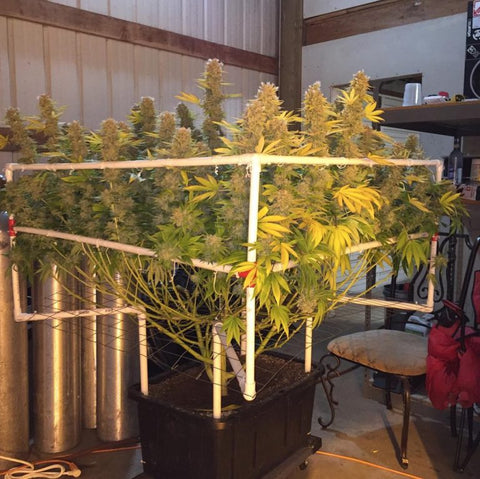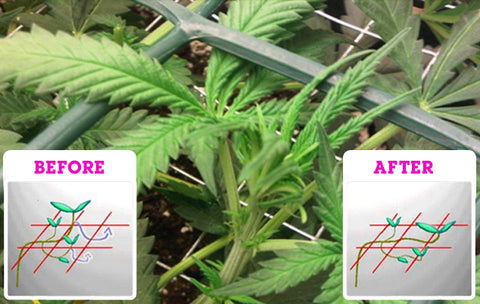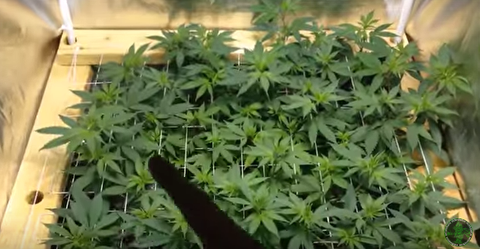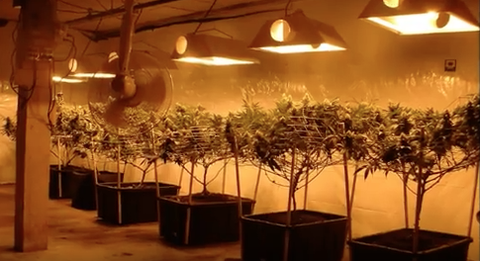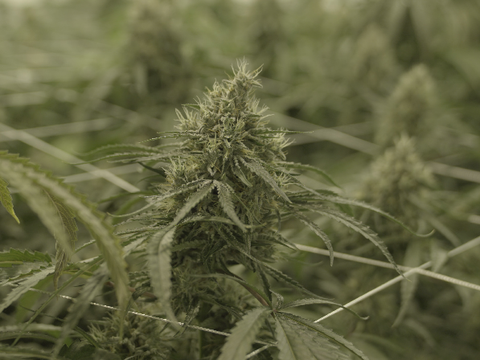ScrOG blOG™ — scrog screen
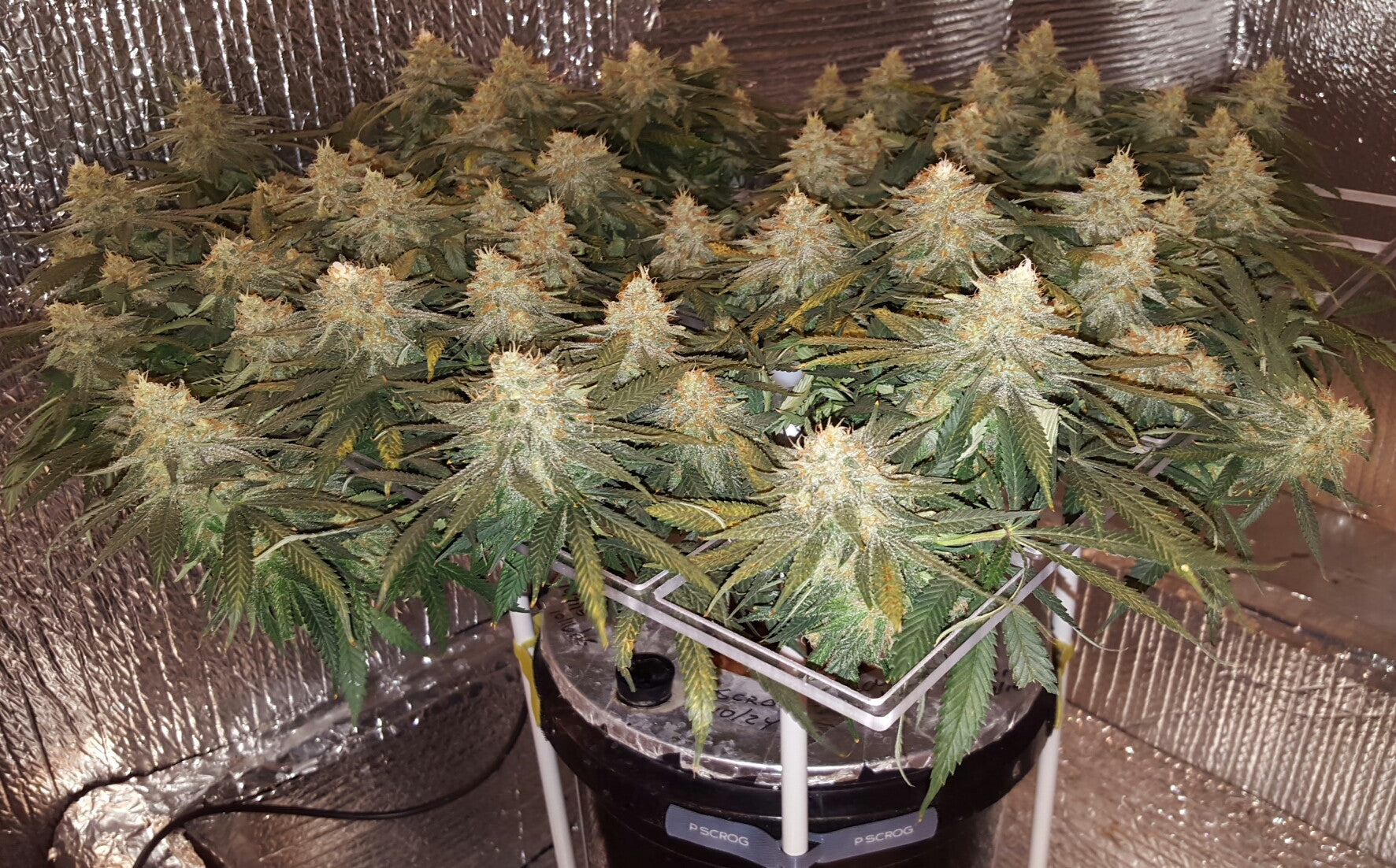
Best "How to ScrOG" Guides
Sea of Green (SOG) vs Screen of Green (ScrOG)
A great deal of confusion exists regarding the difference between Sea of Green (SOG) vs Screen of Green (ScrOG) methods of growing cannabis. Before I present what I consider to be some of the better "How to ScrOG" Guides, allow me to briefly define the difference between SOG and ScrOG.
SOG - SOG is used to create "perpetual harvests". The method involves high plant counts per cu ft and short grow cycles. Clones are introduced to 12/12 flowering with little to no veg cycle. Trellis or other screen material may be used to support heavy colas but no plant training techniques are used. Many growers cannot use SOG due to local plant count limitations.

Sea of Green (SOG), multiple plants
ScrOG - The ScrOG method involves lower plant counts, typically 1 plant per 2'x2' area. Veg periods vary, with longer veg periods resulting in canopies larger than 2'x2'. Screens are used to facilitate plant training which results in short bushy plants with virtually all target bud sites in the best lighting zone. ScrOG method is touted to produce 2 to 3 times the yield of traditional growing methods.

There are a number of variations of the ScrOG method. We have scoured the internet and selected what we consider to be some of the better "How to Guides" below.
Argument for single plant ScrOG
The original Screen of Green (ScrOG) was invented and popularized by Wolf Segal of Portland, Oregon. Previously, underground growers (including Wolf) would use SOG (Sea of Green) to ensure perpetual harvests. SOG puts several plants under one screen. Wolf was arrested and jailed during operation "Green Merchant" in the 90s and gained the distinction of having the highest plant count in history. Wolf then came up with the concept of ScrOG to dramatically reduce plant counts and at the same time maintain high yields.
Growers who have embraced the concept of ScrOG have found far more benefits than just reducing plant counts.
Why do many growers prefer single plant ScrOGs?
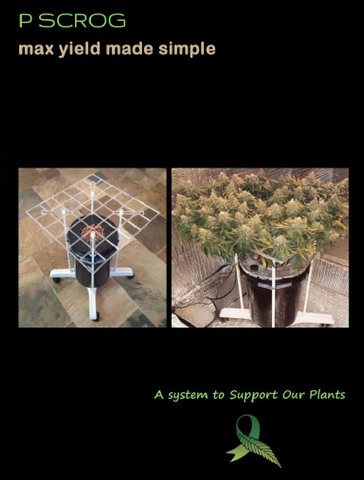
P SCROG Techniques
- Ease of providing individual plant care - When 2 or more plants are placed under a single ScrOG net, those plants are typically treated the same out of necessity. Growers have trouble getting to plants at the far reaches of the grow. All plants are treated the same despite their strain maturity level or health.
- Simple to move around if necessary - If you need to pull a plant from a grow for any reason, you need to cut the net and remove it, leaving remaining plants unsupported.
- Improved light distribution - Growers can rotate, custom adjust heights, plants grow at different rates and mature a different rates.
- Easy to remove troubled plant from grow space, lowers risk of damage to remaining crop
- Easier to water and flush
- Allows gardener to harvest plants individually at precise maturity
- Eliminates crawling under nets/wire mesh
- Wheel chair / handicap accessibility
- Irrigation equipment accessibility
- A single plant can be scrogged at an optimal time in its growth cycle. Otherwise, only the most aggressive growing plants enjoy the full benefit of Screen of Green.

P SCROG Techniques

MAXIMIZE YIELD
with
P SCROG Kits
P SCROG support 7 days a week - 512-528-6028
or
SupportOurPlants@SCROGGER.com
or
SupportOurPlants@SCROGGER.com
- Gary Memelstein
- Tags: best how to scrog guides best scrog guides cannabis plant training grow lights growing cannabis how to scrog hydroponics indoor grow lollipopping lst optimal light band intensity scrog scrog kit scrog method scrog product scrog screen scrog technique scrogging topping trellis trellis net
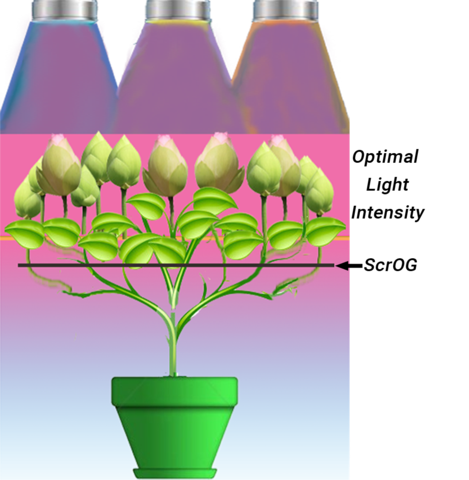
Optimizing Light
Plant training methods have been around for hundreds of years. In the 17th century, the French developed a technique called “espalier” which was used both for decorative and fruit production purposes.

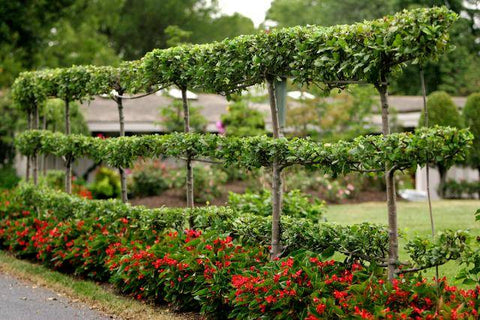
Espaliered Pear and Apple Trees (above)
” The most important advantage (of espalier) is that of being able to increase the growth of a branch by training it vertically. Later, one can decrease growth while increasing fruit production by training it horizontally.” 1
Scrogging builds on the espalier technique to grow short, bushy horizontal plants allowing for maximum bud development. The main stem of the plant is forced to multiply by Topping. Low Stress Training (LST) is accomplished by bending the branches of stems under the lower training screen resulting in more bud development per branch. Lollipopping all leaves of lower branches focuses the energy upward to bud development. A flat horizontal plane of buds, developing all in unison, can be placed in the optimal light intensity band at the same time. No buds are stunted due to upper growth shading and all plant energy is focused solely on bud development.
Scrogging builds on the espalier technique to grow short, bushy horizontal plants allowing for maximum bud development. The main stem of the plant is forced to multiply by Topping. Low Stress Training (LST) is accomplished by bending the branches of stems under the lower training screen resulting in more bud development per branch. Lollipopping all leaves of lower branches focuses the energy upward to bud development. A flat horizontal plane of buds, developing all in unison, can be placed in the optimal light intensity band at the same time. No buds are stunted due to upper growth shading and all plant energy is focused solely on bud development.
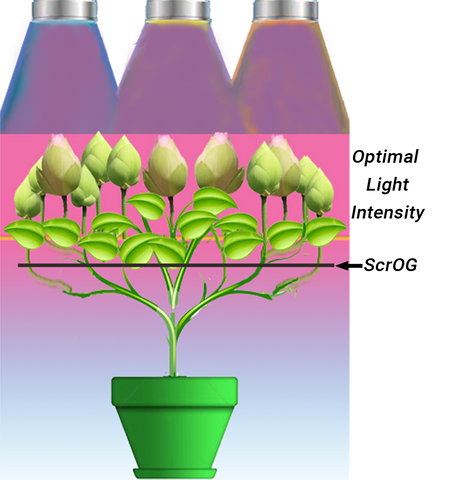
Most references to the ScrOG method espouse 2 to 3 times increase in bud yield.2
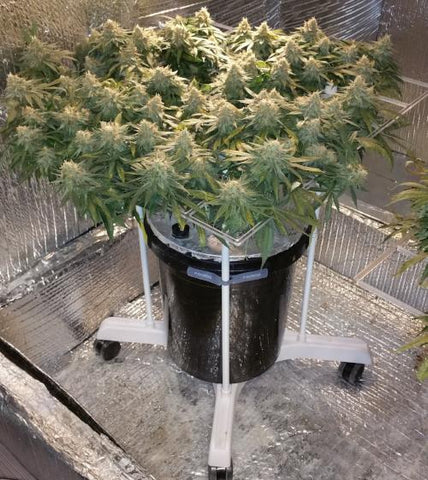
P SCROG Primary System
References
1. Wikipedia “espalier” 2. GrowWeedEasy.com


MAXIMIZE YIELD
with
P SCROG Kits
P SCROG support 7 days a week - 512-528-6028
or
SupportOurPlants@SCROGGER.com
or
SupportOurPlants@SCROGGER.com
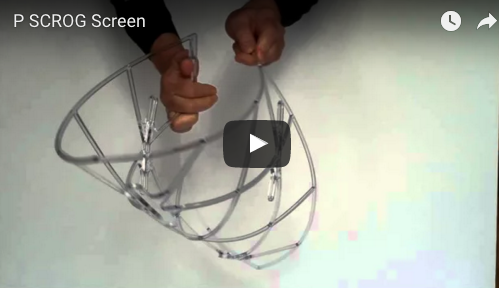
Double yield for $5
Would you pay $5 per plant each grow to double your yield, some say even triple? P SCROG along with Low Stress Training (LST) can do it for $5 a grow in part because of the superior screen material.
P SCROG screens are molded from polycarbonate resin to provide optimal growing conditions, strength and safety when using the ScrOG method to maximize yield.
Polycarbonate is a lightweight, high-performance plastic that possesses a unique balance of toughness, dimensional stability, optical clarity, high heat resistance and electrical resistance.
Indoor grow spaces by their very nature utilize a dangerous combination of water and electricity to maintain life of plants. Metal ScrOG screens are conductors of electricity and heat and should be avoided in the growing environment to reduce chance of electrical shock, fire hazard and damage to plants. In addition, metal "racking" type material (especially black) can block up to 13%* light during ScrOG training in addition to conducting heat and possibly stunting growth.
P SCROG screens are naturally transparent, with the ability to transmit nearly all available light to plants. The screens have high strength, toughness, heat resistance, electrical resistance and excellent dimensional and color stability.
The general properties can be summarized as follows:
- excellent physical properties
- excellent toughness
- very good heat resistance
-
good chemical resistance
-
electrical resistance
- transparent
- horticulture friendly
The same P SCROG screen material is used to make bullet proof glass.
The following diagram compares the impact strength of polycarbonate to other common polymers.
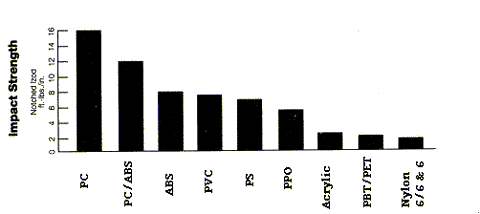
Data from Polymer Technologies & Services, LLC.
SCROGGER warranties P SCROG screens for 5 full years because of the quality and strength of the polycarbonate material. With the P SCROG 4 20 sale, that works out to about $5 a grow** over the warrantied life.
Celebrate 4 20 and save 25%, good now until April 30, 2016. Hurry, only 420 hours left!

MAXIMIZE YIELD
with
P SCROG support 7 days a week - 512-528-6028
or
SupportOurPlants@SCROGGER.com
or
SupportOurPlants@SCROGGER.com
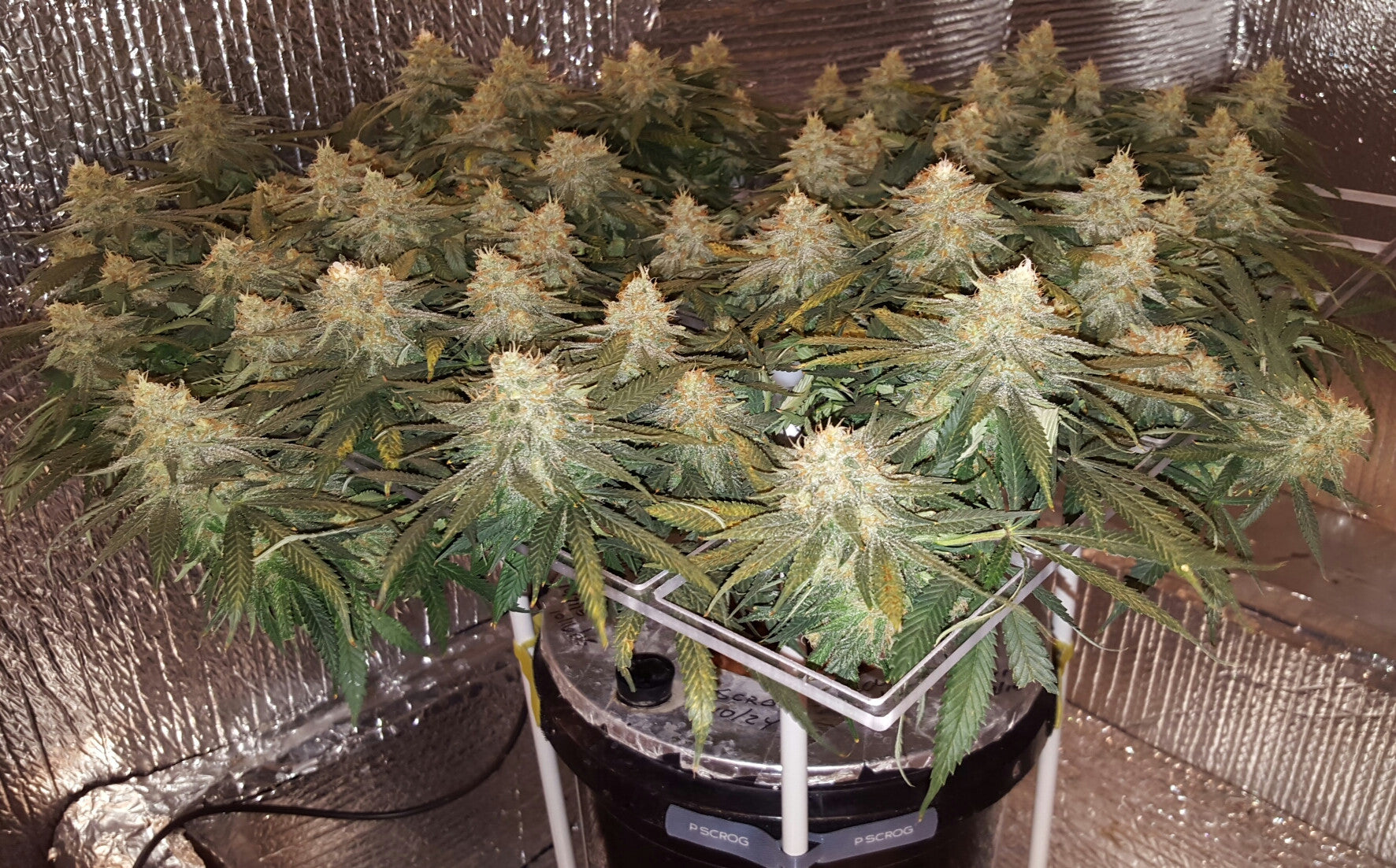
Top or FIM?
Topping or FIMing your cannabis plant is an essential ingredient to promote doubling or tripling yield when using the P SCROG. Instead of one large central cola, topping and FIMing techniques promote multiple branches and bud sites that through low stress training fill the screen of the P SCROG with a bouquet of succulent dense flowers.

Pre-harvest P SCROG
Topping - Cutting the plant above the top node. Topping can and should begin early in vegetative cycle. Each topping produces 2 branches. Two to three toppings during the vegetative cycle will produce 4 - 6 branches with multiple bud sites. As the branches stretch under the screen with use of low stress training (LST), the plant's foliage increasingly fills the P SCROG screen's planar surface. The stretch during training positions the bud sites such that they will grow through the openings of the polycarbonate screen.
Proper topping technique produces even numbers of branches making it possible to fill the screen symmetrically during the training process. Depending upon the strain, a P SCROG screen can reach the target of 75% to 80% full in 30 to 45 days of veg, at which time the plant should begin flowering cycle and should stretch enough to completely fill the screen.
"fuzzygrow" on YouTube

From "GrowWeedEasy.com"
FIMing - "FIM" is a growing culture acronym that stands for "F--K I missed". While not a scientific description of the method, it accurately describes the reaction one might have if you realize you didn't actually top the plant, you instead pinched off the top new growth and missed the rest.
While the FIM method may have been discovered by accident, many people claim it is superior to topping for the following reasons:
1. Produces a shorter bushier plant
2. Less stress and recovery time for the plant
3. Produces 4 branches for each FIMing
LST is performed the same as with topping with the objective of filling 75% to 80% of the P SCROG training screen before switching to flowering cycle.

MAXIMIZE YIELD
with
P SCROG support 7 days a week - 512-528-6028
or
SupportOurPlants@SCROGGER.com
or
SupportOurPlants@SCROGGER.com
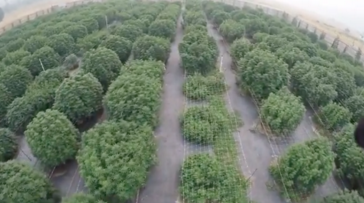
Okanogan Sunflower Farm
Although Okanogan county of Washington state during the gold rush was known for its gold nuggets, Terry Taylor is betting his company will become well known for the Okanogan Sunflower Farm and Okanogan Gold cannabis.
The Okanogan Sunflower Farm is near where the nomadic Northern Okanogans or Sinkaietk tribal group would roam. Their language was Salishan. Descendants of these tribes now occupy the Colville Indian Reservation. Okanogan is Salishan for "rendezvous"...and rendezvous they did!

Left to right, Chief Moses, Chief Tonasket, Chief Sar-sarp-kin. (Courtesy Okanogan Historical Society)
On February 23, 1896, the north half of the Colville Indian Reservation was thrown open for mineral entry, and within weeks, hordes of gold seekers flooded in and staked hundreds of claims. It has been estimated that as many as 1,500 prospectors and other outsiders were waiting just across the Columbia River. The story goes that signal fires were built when official word of the opening was received; these fires touched off a gold rush, and the mining frenzy was on. The gold rush ended in bust leaving the region with record numbers of ghost towns.
Terry Taylor is owner and operator of the Okanogan Sunflower Farm. Terry likes to talk about his great grandfather who lived and worked the land with the indians during the gold rush in what is now Okanogan county. He probably even shared cannabis medicine with the indians before it was prohibited by law.
Like his great grandfather during the Gold Rush, Terry is in the midst of the "Green Rush" frenzy with his 28 acre Okanogan Sunflower Farm and "Okanogan Gold" cannabis brand of bud and extracts. "We can still pan for gold in the Okanogan River which is used for irrigation at the farm", says Terry. "We are located in north central Washington where the mountains meet the desert. This region and its micro climate are ideal for growing high grade cannabis plants."
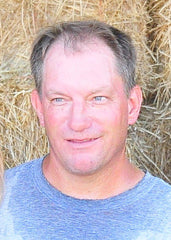
Hear Terry explain his cannabis operation in the YouTube video shot at the Okanogan Sunflower Farm, why he feels all plants should be ScrOGged and his predictions for the future of the cannabis industry. The drone footage is incredible. Please watch!

MAXIMIZE YIELD
with
P SCROG Kits
P SCROG support 7 days a week - 512-528-6028
or
SupportOurPlants@SCROGGER.com
or
SupportOurPlants@SCROGGER.com
- Gary Memelstein
- Tags: cannabis plant training growing cannabis how to scrog indoor grow indoor growing lollipopping low stress training lst outdoor grow screen of green scrog scrog kit scrog kits scrog marijuana scrog method scrog net scrog pot plants scrog screen scrog weed scrogging topping trellis trellis net
